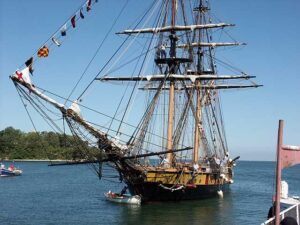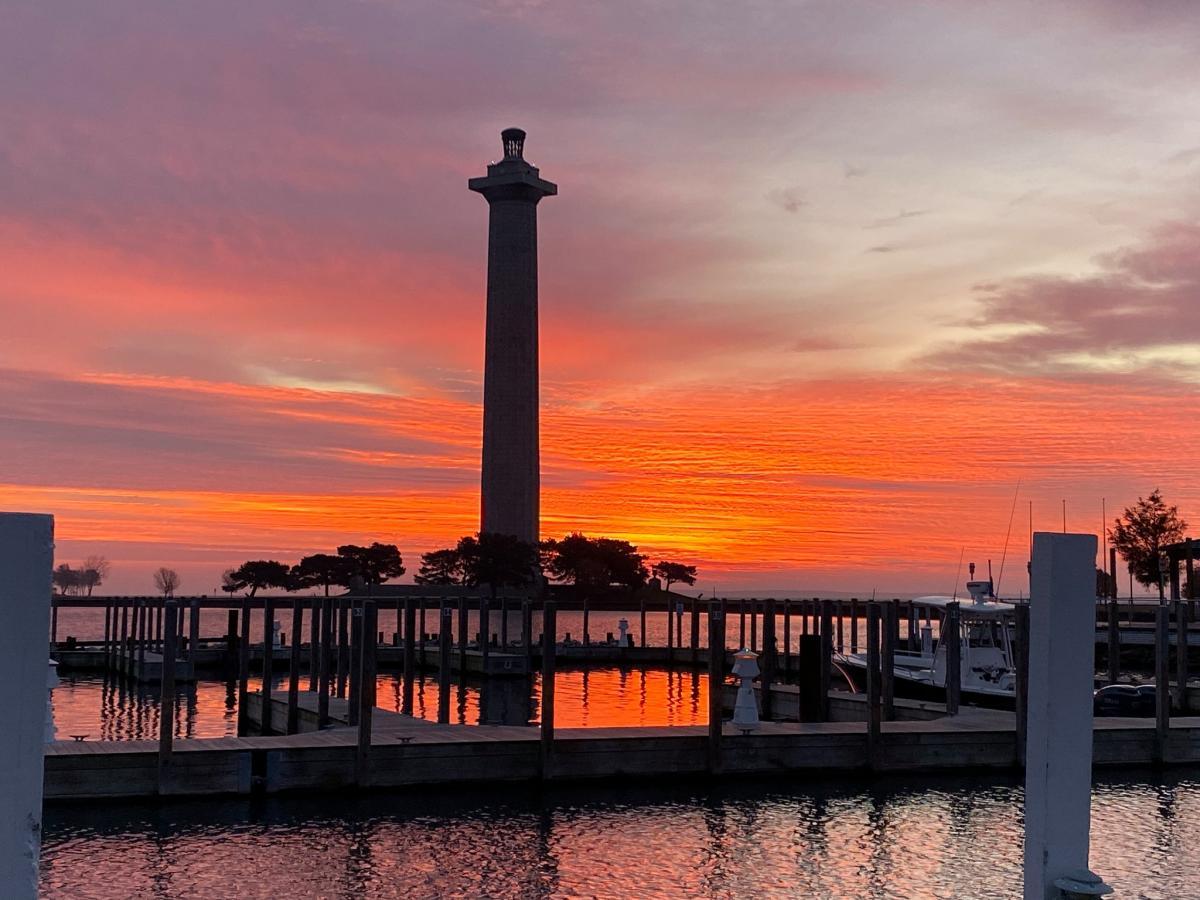History Of Put-in-Bay

Put-in-Bay’s History dates back over 200 years, full of colorful characters, significant battles, and memorable events that shaped Put-in-Bay as we know it today!
![]()
Found in the shallow western basin of Lake Erie is a cluster of 20 or more islands, many of which were a part of Put-in-Bay History. One of these, known as South Bass Island, or Put-in-Bay, functioned as a headquarters for operations by Oliver Hazard Perry.
The American triumph in the battle of Lake Erie gave the nation and the United States Navy an unforgettable catchphrase of upbeat accomplishments, “We have met the enemy, and they are ours….” Perry sailed from the Put-in-Bay port to defeat the British fleet under Robert H. Barclay during the war of 1812.
 Today a stunning Greek Doric column, the Perry’s Victory and International Peace Memorial, is visible from miles away. This 352-foot granite column commemorates a naval battle and a peace that has lasted for over 150 years. The 3,987-mile border between the United States and Canada is the lengthiest unguarded international boundary in the world.
Today a stunning Greek Doric column, the Perry’s Victory and International Peace Memorial, is visible from miles away. This 352-foot granite column commemorates a naval battle and a peace that has lasted for over 150 years. The 3,987-mile border between the United States and Canada is the lengthiest unguarded international boundary in the world.
Put-in-Bay History is re-enacted every day in season at the bottom of the monument. Visitors who vacation at Put-in-Bay can ride an elevator to the peak of the monument to an observation patio offering breathtaking vistas of Detroit, Toledo, and Cleveland skylines on a clear day.
EARLIEST VISITORS IN PUT-IN-BAY’S HISTORY
According to Put-in-Bay History, the earliest travelers to the island were the American Indians. To this day, Indian arrowheads, stone axes, and other implements of blue and white flints turn up during construction.
Indians visited Put-in-Bay when ice conditions allowed the crossing to hunt raccoons and other creatures. The earliest white inhabitants known to have occupied the Islands were the French. French explorer and fur trader Louis Jolliet was the first white man to cross the lake. An unidentified group of explorers drifted among the islands in July of 1784.
They made diagrams of the islands, anointing one of them, Pudding Bay, because the shape of the harbor (or Put-in-Bay) looked like a pudding bag. Other logbooks referred to the port as Puden Bay.
The Lake Erie Islands were part of the tract of land claimed by Connecticut, known as the Western Reserve. Seth Done brought several laborers who cleared over 100 acres of ground and grew wheat in the summer and fall of 1811. He also brought over 400 sheep and 150 pigs to feed on the hickory and acorn nuts which were plentiful on the island.
The first attempt to settle on Put-in-Bay ended with the arrival of the war of 1812. The hirelings were busy threshing seed when the British fighters forced them off in the fall of 1812 and eliminated the rest of the harvest.
Put-in-Bay History & The War Of 1812
Western Lake Erie and the surrounding land areas in Ohio, Michigan, and the Canadian province of Ontario were the locations of skirmishes and conflicts during the War of 1812. The American cause suffered several humiliating losses at the outset of the fight. General William Hull’s attack on Canada failed, and Hull, in shame, sacrificed Detroit to the British in August 1812. The troops under General James Winchester were annihilated at the River Raisin (Monroe, Michigan), in January 1813.
British and Indian invasions of Ohio at Fort Meigs (Perrysburg) and at Fort Stephenson (Fremont) were repelled in May and August. The war’s turning point in The Old Northwest came with Oliver Hazard Perry’s victory over the British Armada in the Battle of Lake Erie on Sept. 10, 1813. The naval triumph made it feasible for General William Henry Harrison to invade Canada and conquer the British and Indians at the River Thames in October 1813.
Perry used Put-in-Bay Harbor as a base of operations. From the Bass Islands, he could rapidly sail to Sandusky Bay for meetings with Harrison or scout the British troops at Fort Malden (Amherstburg, Ontario), in the Detroit River. When the soldiers and vessels needed to be more involved, there were practicum tasks such as equipping the ships for activities and gunnery training.
The American caravan had voyaged from Erie, Pennsylvania, on Aug. 12, 1813, and reached Sandusky Bay on the sixteenth. A sentry discovered the British fleet under Captain Robert H. Barclay in the masthead of Perry’s flagship, the brig Lawrence, at 5:00 a.m., Friday, Sept. 10, 1813. Perry consulted with Generals Lewis Cass And Harrison regarding the next step in prosecuting the crusade.
The Battle of Lake Erie began at 11:45 a.m. and concluded a few minutes after 3:00 p.m. British dominance on Lake Erie came to an end with the capture of the whole enemy fleet of six ships. The battle began eight miles northwest of Put-in-Bay and reached its finale at West Sister Island, fourteen miles out. The jubilant American leader scribed a short note on the back of an old note to William Henry Harrison, creating Put-in-Bay History:
U.S. Brig Niagara, Off Western Sister Island head of Lake Erie, Sept. 10, 1813, 4 p.m.
Dear General —We have met the enemy, and they are ours; two ships, two brigs, one schooner, and one sloop.
Yours with great respect and esteem,
O.H. Perry
Post-War Put-In-Bay History
With the War of 1812 behind, Aschell (Shell) Johnson lived on Put-in-Bay for three years. The subsequent immigrants were Henry and Sally Hyde, who arrived in 1818. The Hydes came with 500 heads of sheep on the island. A.P. Edwards began developing Put-in-Bay, transporting laborers to erect the important buildings. John Pierpoint built the first dock in Put-in-Bay harbor and another one referred to as the West Dock.
The first permanent homesteader to come to Put-in-Bay was Philip Vroman in 1843. He settled on the island until his demise 68 years later. In 1845 Gibraltar Island, located in the harbor, was occupied by a group of government surveyors and engineers. They were immersed in making diagrams of the lake. They found it critical to cut a path 45 feet wide running through the forests of Put-in-Bay to site their instruments properly. The islanders used the strip as a road called “Sight Road .”Today it is referred to as Langram Road or airport road.
The History Of Jose De Rivera
In 1854 a Spanish trader named Joseph de Rivera bought South Bass, Middle Bass, Gibraltar, Sugar, Starve, and Ballast Islands for $44,000. He built on the islands, creating a sawmill and a starve mill in late 1854. He retained the county engineer to survey the region in 10-acre parcels. In the next ten years, de Rivera sold 42 South and Middle Bass Islands properties. He dealt a quarter acre of ground to the South Bass Board of Education for just one single dollar, the most reasonable price in Put-in-Bay History. In his honor, the park downtown is named De Rivera Park, and a trust is accountable for the park and other lands still today.
The wine-making and grape-growing industry commenced on the Lake Erie Islands in the 1850s, and Put-in-Bay’s lure as a historical island resort was growing! Large celebrations took place in 1852, 1858, and 1859 celebrating Oliver Hazard Perry’s victory over the British in 1813. Put-in-Bay was evolving as a popular place with its delicious grapes and exceptional wines.
Put-in-Bay was also a place where the tourist, via the steamboat, could “get away from it all” for a couple of days. The population increased as farmers reached the island to farm vineyards and others became engaged in the resort industry. Approximately 500 individuals were permanent inhabitants of South Bass Island, Put-in-Bay, by the early 1860s.
In 1866 an account in the Sandusky Daily Commercial Register spoke of the blossoming Put-in-Bay township. Islanders possessed 165 cattle, 103 horses, 206 pigs, and one lone mule. The parcels were planted in oats, wheat, rye, buckwheat, barley, sorghum, potatoes, hay, tobacco, and clover. The grape vineyards were a primary source of income. Over 72 acres were planted by 1865 to bring the tally to 422. Grape production for 1865 tallied 1,117,801 pounds, and 33,806 gallons of wine were pressed. The hereafter looked optimistic for island growers.
The History Of South Bass Island Government And Management
Local island governance was now wanted. To this end, John Stone, Simon Fox, and others from the three Bass Islands requested of the Ottawa County commissioners’ permission to form a Put-in-Bay township. On Jun. 22, 1861, the voters picked their township trustees, celebrating a first in Put-in-Bay History. In May of 1876, 15 years after the three islands were organized as a township, a portion of South Bass was incorporated as a village. Today we now refer to that area as downtown Put-in-Bay.
The St. Paul’s Episcopal Church was constructed in 1865 on ground bought by Jay Cooke from Jose DeRivera for $10.00. Land for the local school was sold for just $1.00. The deed to the ground specified it was for constructing an Episcopal church. Island residents introduced the initial funds to build a church and were assisted by funds from Jay Cooke. Cooke’s beneficiaries gave the ground to the Episcopal church in the early 1900s. The Mother of Sorrows Catholic Church was established in 1866.
The Put-in-Bay Telegraph Company was formed in 1873 with a two and seven-eighth-mile cable connecting the point of Catawba Point and South Bass Island. In the 1930s, dial phones superseded old hand-cranked wall-type devices. In May 1906, modern street lights were converted to electricity.
The History Of The Steamship Era Thru Put-in-Bay Today
In its peak, around the 1850s to the 1900s, numerous steamships, some carrying up to 1,500 passengers, arrived on the island regularly. Tourists enjoyed a variety of hotels, including the 300 x 600-foot Hotel Victory with 625 guest rooms. At that time, is was the largest resort hotel in all of America, featuring the first coed swimming pool. Intricate ceremonies were held for the laying of the cornerstone of The Hotel Victory. Seven steamships brought over 8,000 individuals to Put-in-Bay.
The Beebe house, with a vast hall running 500 feet via the center, had a dining room that could seat nearly a thousand people. The resort could accommodate over 800 individuals. Unfortunately, the Victory Hotel caught fire and burned to the ground before it could be fully enjoyed.
Put-in-Bay Today! History In The Making
The brigs, sloops, and ships with their cannonades and long guns are gone. In their place are sleek yachts and sailboats. Many skippers of these pleasure crafts plot a route to Put-in-Bay, pursuing respite from the stresses of the city. Others — are tourists— boarding our ferryboats or flying by airplane to the local Put-in-Bay Airport for their journey. The island is now known as Ohio’s Lake Erie vacation land. Visitors from thousands of miles away have been coming to Put-in-Bay for over 100 years.
From the observation deck of the Perry Memorial, visitors can survey the Battle of Lake Erie site. Vacationers can also probe the depths of island caves, drive a Put-in-Bay Golf Cart Rental around the island, or sip locally produced grape juice and wines.
Resort Destination And Family Friendly Vacations
Put-in-Bay has been a summer resort for better than 100 years. Today, Put-in-Bay is a vibrant tourist resort with popular bars, hotels and resorts, boating, fishing, a national monument, golf cart rentals, caves, and much more. For more details on the History of Put-in-Bay, we suggest you read the book by Robert Dodge called Isolated Splendor. A large part of the information for this Put-in-Bay history page was obtained from his book. Visit the South Bass Island, or Put-in-Bay as it is better known, and see for yourself. Who knows? Perhaps you and your family will make a little Put in Bay History!



